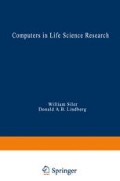Abstract
The Rutgers Research Resource on Computers in Biomedicine1 was established about 3 years ago with the objective of bringing advances in computer science—particularly in artificial intelligence and in interactive data base systems—into problems of biomedical inquiry. The main thrust of the Resource is to develop ways of using the computer as an integral part of the inquiry process. Our thesis is that the computer can be made to play an important role in this process if its potential for symbol manipulation is used to provide ‘intelligent assistance’ in the organization of scientific knowledge and in its utilization for problem solving.
Access this chapter
Tax calculation will be finalised at checkout
Purchases are for personal use only
Preview
Unable to display preview. Download preview PDF.
References
Amarel, S. Problems of representation in artificial intelligence. In: Purposive Systems, edited by H. Von Foerster et al. New York: Spartan, 1969
Amarel, S. On the representation of problems and goal directed procedures for computers. In: Formal Systems and Non-Numerical Problem Solving by Computer, edited by R. B. Banerji and M.D. Mesarovic. New York: American Elsevier, 1970.
Amarel, S. Representations and modeling in problems of program formation. In: Machine Intelligence 6, edited by Meltzer and Michie. Edinburgh: Univ of Edinburgh Press, 1971.
Amarel, S., and C. Kulikowski. Medical decision making and computer modeling. Proc. Subconf. Computers in Biomedicine, 5th Hawaii Intern. Conf. Systems Sci. January 1972.
Buchanan, B., and J. Lederberg. The heuristic Dendral program for explaining empirical data. Proc. Intern. Federation Information Processing Soc. 1972, p. TA-2-91-100.
Fabens, W. J. H. Pedaglot users manual. CBM-TR 12 New Brunswick N.J.: Rutgers Univ., Dept. of Computer Sci., 1972.
Feigenbaum, E. A., B. G. Buchanan and J. Lederberg. On generality and problem solving: A case study using the dendral program. In: Machine Intelligence 6, edited by Meltzer and Michie. Edinburgh: Edinburgh Univ. Press, 1970.
Heider, F. The Psychology of Interpersonal Relations. New York: Wiley, 1958.
Kolker, A. E., and J. Hetherington, Jr. Becker-Shaffer’s Diagnosis and Therapy of the Glaucomas (3rd ed.) St. Louis: Mosby, 1970.
Kulikowski, C. A., and S. Chokhani. Proc-ess control model for the regulation of intraocular pressure and glaucoma. CBM-TR-17 New Brunswick, N.J.: Rutgers Univ., Dept. of Computer Sci., 1973.
Kulikowski, C. A., and S. Weiss. Computer based models of glaucoma. CBM-TR-3 New-Brunswick, N.J.: Rutgers Univ., Dept. of Computer Sci., 1971.
Kulikowski, C. A., and S. Weiss. Medical Consultant Program-GLAUCOMA (MCP-G1). CBM-TR 5 New Brunswick, N.J.: Rutgers Univ., Dept. of Computer Sci., 1972.
Kulikowski, C. A., and S. Weiss. Strategies for test selection in causal network models. CBM-TR 11 New Brunswick, N.J.: Rutgers Univ., Dept. of Computer Sci., 1972.
Kulikowski, C. A., S. Weiss and A. Safir. Glaucoma diagnosis and therapy by computer. Proc. Ann. Meeting Assoc. Res. Vision Ophthalmol. May 1973.
Schmidt, C. F. A computer simulation model of the social perception of interpersonal episodes. CBM-TM 11A New Brunswick, N.J.: Rutgers Univ., Dept. of Computer Sci., 1972.
Schmidt, C. F., and J. D’Addamio. A model of the common-sense theory of intention and personal causation. Proc. 3rd Inter. Joint Conf. Artificial Intelligence. Stanford, Calif., 1973.
Weiss, S. M. A system for model-based computer-aided diagnosis and therapy. CBM-TR-27. (Ph.D. Thesis) New Brunswick, N.J.: Rutgers Univ., Dept. of Computer Sci., 1974.
Author information
Authors and Affiliations
Editor information
Editors and Affiliations
Rights and permissions
Copyright information
© 1974 Springer Science+Business Media New York
About this chapter
Cite this chapter
Amarel, S. (1974). Computer-based modeling and interpretation in medicine and psychology; the Rutgers Research Resource. In: Siler, W., Lindberg, D.A.B. (eds) Computers in Life Science Research. FASEB Monographs, vol 2. Springer, Boston, MA. https://doi.org/10.1007/978-1-4757-0546-1_12
Download citation
DOI: https://doi.org/10.1007/978-1-4757-0546-1_12
Publisher Name: Springer, Boston, MA
Print ISBN: 978-1-4757-0548-5
Online ISBN: 978-1-4757-0546-1
eBook Packages: Springer Book Archive

